My custom 25 gig router/firewall build (2025)
My current internet connection at home is 1 Gbit/s symmetric up/down on fiber for about CHF 65.-/month. But my ISP also offers 10 Gbit/s and even 25 Gbit/s on the same line for the same price! I'd merely have to invest in different optics and pay a one-off setup fee. For an extremely nerdy, data-hungry household like ours that's a no-brainer, right? Only problem is that my current firewall (Zyxel ZyWALL 110) only manages up to 1 Gbit/s and has been end-of-life since late 2022. Also, the LAN side is currently only set up for 1 Gbit/s (switches, Cat 5e wiring) - that will have to be upgraded eventually, as 10 gig consumer gear becomes more readily available, but that's a story for another time...Looking at the current market for 25 gig capable, off-the-shelf router/firewall hardware, it quickly becomes clear that there are very few affordable options. There are some economically priced options from budget brands like Mikrotik or Ubiquiti, but the fact that they feature 25 Gbit/s interfaces (SFP28 fiber optics) does not imply that their CPUs can effectively handle 25 Gbit/s throughput, especially with more complex traffic like SSL VPN.
Encouraged by others who have been in the same spot (like https://michael.stapelberg.ch/posts/2021-07-10-linux-25gbit-internet-router-pc-build/ or https://sschueller.github.io/posts/wiring-a-home-with-fiber/#router) I decided to build my own custom router/firewall from standard PC parts.
My initial goals and constraints:
- effectively handle 25 Gbit/s traffic (at least for NAT routing), and aim for VPN throughput as high as reasonably possible
- low energy consumption (this router will run 24/7 and should therefore use as little power as possible)
- use standard PC hardware on a budget (not the cheapest, but not overly expensive either)
- well-established, open-source operating system
- SSL VPN access to home network
Software picks
OS
Coming from the comfortable admin GUI of my previous firewall, I had initially set my sight on OpnSense community edition (https://opnsense.org/). I'm not a networking pro, so I figured I'd have the best chance to "get it right" by having a web GUI guide me through networking OS setup and configuration. However, after talking to others with OpnSense experience, I learned that it might not be the best choice for a high-throughput router/firewall OS. Based on FreeBSD, it appears to have scalability limitations which may prevent me from reaching my 25 gig target. The makers of the commercial equivalent, pfSense (https://pfsense.org/), have apparently implemented custom tuning tweaks to improve on that, but these are of course not available in the OpnSense community editions. I haven't ruled out OpnSense completely and may come back to it some day, but for now I'll go a different path.Based on various recommendations I then looked int VyOS (https://vyos.io/). They also have commercial subscriptions as well as freely available "nightly builds" (https://vyos.net/get/nightly-builds/). Nightly builds are a bit of a risk (and would be a definite no-go in a professional setup), but I guess in my context I can justify it. There is no established (web) GUI for VyOS (although there apparently have been some projects attempting that). It's command line only, which I am totally fine with. I'm a software developer and DevOps engineer by trade, so that's my daily bread and butter, and I am also a big supporter of "configuration as code" which is how VyOS externalizes their instance setup. I'm just a bit doubtful whether my networking skills will suffice to construct a full-blown and secure home router/firewall from scratch. So I guess there will be a lot of learning on the way, but that is also part of the fun and motivation of this project.
I see a lot of public interest in VyOS lately, so I guess I'm not totally off the track. For example, I'm following Tomaž Zaman on YouTube (https://www.youtube.com/playlist?list=PLmSwDz13rIwLkLphPI7xmUSD4DqdkFBKp), he is apparently also considering VyOS for his router project now. However, the makers of VyOS have been criticized lately by the community for their licensing decisions: VyOS is no longer open source in the classic sense (e.g. LTS releases are closed source), and that may not bode well for the future... But alas, rolling VyOS releases is what I'll go with for now.
Virtualization
I'm normally a huge fan of virtualization (for flexibility and ease of operation), but in this case networking performance is one of the primary goals, so I stayed away from a hypervisor to make sure I have the full potential of handing off package processing load from the CPU to the bare metal network card. So, no Proxmox (https://www.proxmox.com) or similar for now.The long wait for hardware
CPU
The market for low-power CPUs has been exploding, driven by smartphone, tablet and data-center demand for powerful, yet low-power hardware, and by Apple's progress with their own ARM-based silicon. However, due to my software pick (see above) I was limited to x64 architecture CPUs. Since (some) AMD CPUs are known for their outstanding energy efficiency, I focused on AMD Ryzen processors, particularly the 35W TDP models, and preferably those with an integrated GPU (to avoid the power draw of a superfluous graphics card). I knew there was a "5700GE" in the Ryzen 7 (5000) series, but that was already a couple of years old (announced April 2021). I would rather start with a more recent CPU, but AMD never came out with any 35 W Ryzen 7 for the newer 7000 series. Finally, in April 2024 AMD announced the Ryzen Pro 8700GE (35W TDP) which fits the bill (https://www.amd.com/en/products/processors/desktops/ryzen-pro/8000-series/amd-ryzen-7-pro-8700ge.html). The only problem was that this CPU is not a "consumer" product, but primarily targeted at OEMs, like the new Lenovo ThinkCentre M75q Gen 5 Tiny (https://www.lenovo.com/us/en/p/desktops/thinkcentre/m-series-tiny/lenovo-thinkcentre-m75q-gen-5-tiny-amd/len102c0051), or the new Hetzner cloud server AX42 (https://www.hetzner.com/dedicated-rootserver/ax42/). Consequently, this CPU was virtually unavailable on the end-user market. European distributors were delaying their "back in stock" prediction week by week. Engineering samples started showing up on Ebay, but those were obviously pre-production and crazy expensive. When in August 2024 one Ebay seller in China started offering "used" Ryzen Pro 8700GE CPUs for USD 440.- I had run out of patience and ventured the risk. I received a brand new legit AMD CPU, fully operational, no issues so far.Case/Motherboard
At the same time I needed to find a suitable motherboard and case. Asrock had just announced their DeskMeet X600 Series (https://www.asrock.com/nettop/AMD/DeskMeet%20X600%20Series/index.asp) barebone:- small size case (8l)
- modest 500W power supply included
- AMD socket AM5 (for Ryzen 9000/8000/7000 series CPUs)
- 4 DIMM slots for up to 256 GB DDR5 memory, ECC capable (!)
- M.2 Socket (type 2280) PCIe Gen5x4 (up to 128 Gb/s)
- PCIe 4.0 x 16 slot for fast ethernet network adapter (this slot is actually meant to host a discrete, dual slot wide graphics card which I don't need, as graphics are provided by the CPU)
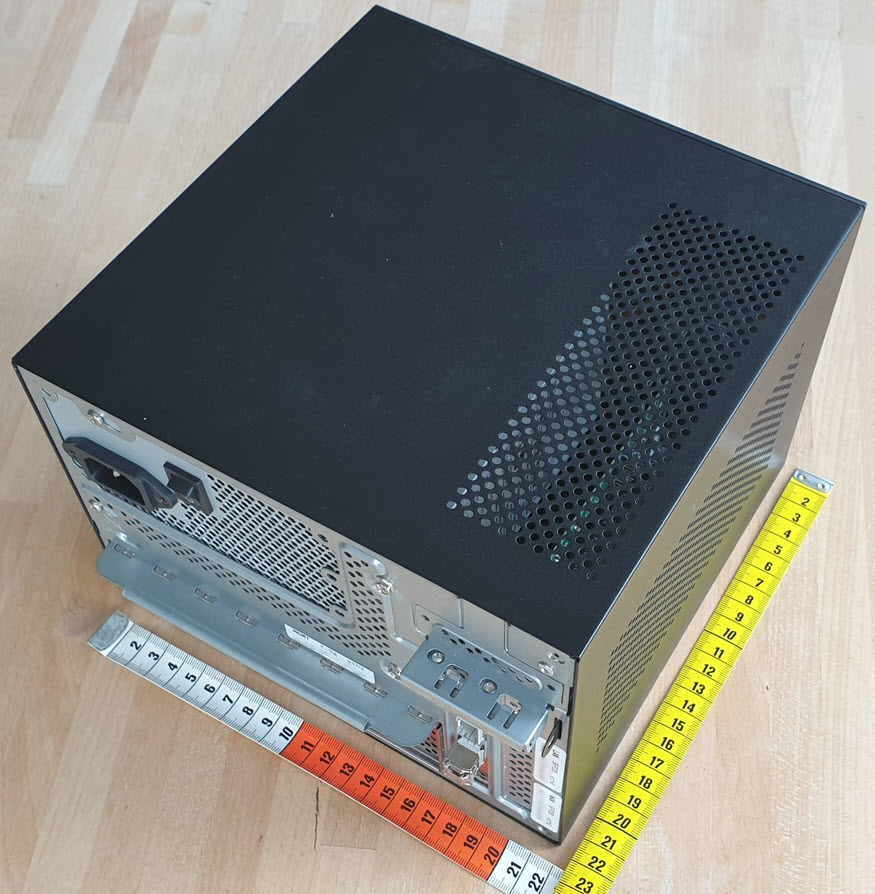
Network Card
Having a fast, modern PCIe 4.0 x 16 slot available is an essential requirement for running a discrete ethernet network card to take on the bulk routing load at up to 25 Gbit/s (the on-board 2.5 Gbit/s network port is only used for server management).There are various vendors offering network cards with 2x or 4x SFP28 ports. In the end, I decided for a genuine (i.e. non-rebranded) Intel E810-XXVDA2 (https://ark.intel.com/content/www/us/en/ark/products/189760/intel-ethernet-network-adapter-e810-xxvda2.html)
which appears to be well supported by Linux kernel drivers and allows to offload various types of packet processing. It has 2 SFP28 ports for up to 25 Gbit/s each. There is also a E810-XXVDA4 model by Intel (https://ark.intel.com/content/www/us/en/ark/products/192560/intel-ethernet-network-adapter-e810-xxvda4.html) with 4 SFP28 ports, but that is twice the price and only makes sense if the local network is actually 25 gig capable (using 3 internal 25 gig ports).
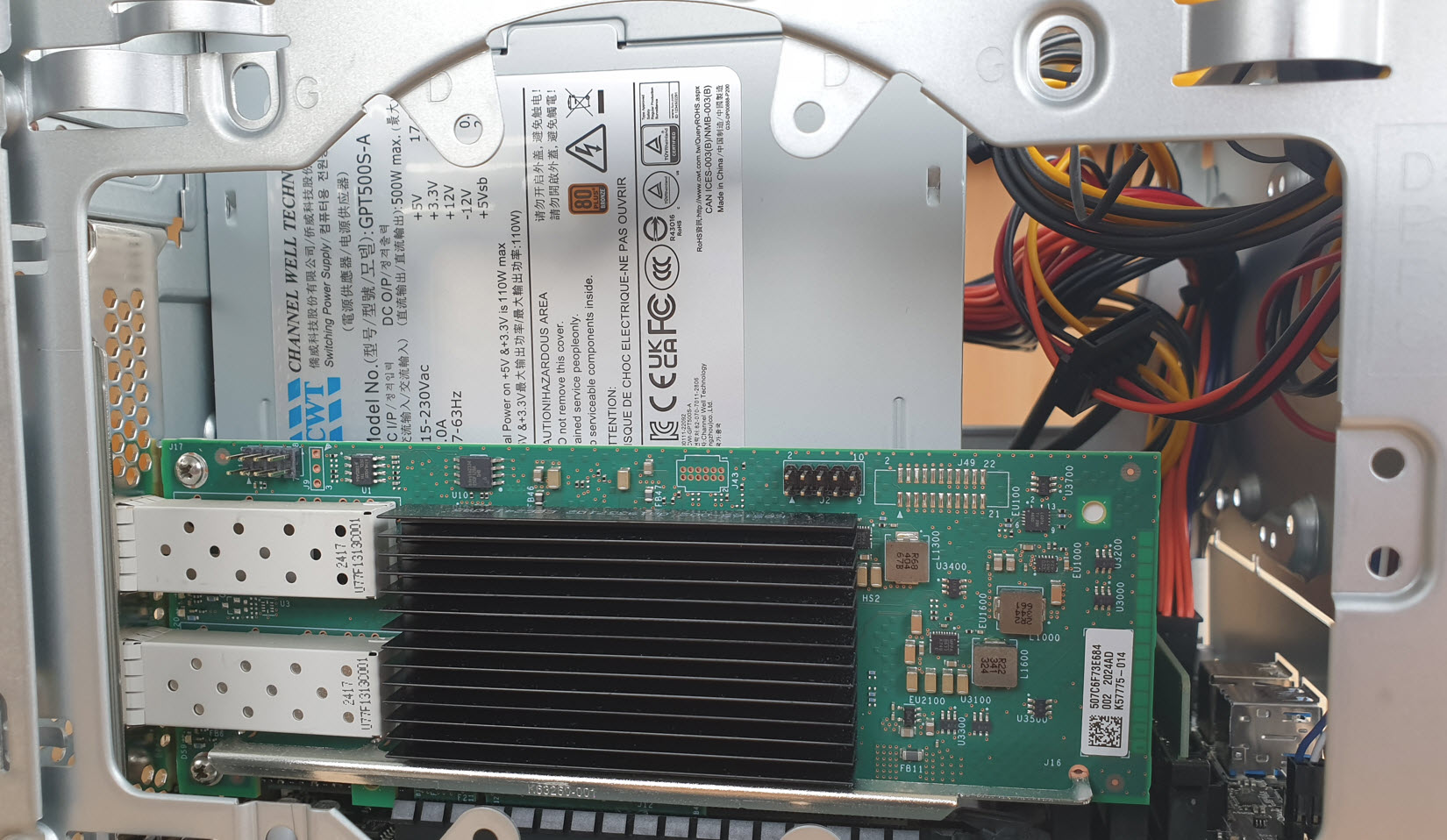
Memory
Since the chosen motherboard supports ECC memory, I decided to give it a try. I'm not sure yet whether it's a good choice for a router/firewall application, but I kind of liked the potential "peace of mind" that comes with automatic error correction on a 24/7 server, hoping for less required troubleshooting and maintenance work. From previous PC builds I had positive experiences with Crucial memory (a Micron brand), so I looked for fast but affordable ECC DIMMs of that brand. I purchased two Micron 32GB DDR5-5600 ECC UDIMM 2Rx8 CL46 sticks (https://www.crucial.de/memory/ddr5/mtc20c2085s1ec56br) directly from their web shop at crucial.com. 64 GB should be plenty of memory for a router/firewall machine, with enough leeway for running additional services on the same machine. With only 2 of the 4 memory slots populated, there is also room for further expansion to a maximum of 128 GB (or even 256 GB if one is willing to replace the existing memory with 64 GB sticks). Crucial memory is not listed on Asrock's QVL (https://www.asrock.com/nettop/AMD/DeskMeet%20X600%20Series/index.asp#Memory) but the parametric search on Crucial's web site (https://www.crucial.com/compatible-upgrade-for/asrock/deskmeet-x600-series) reports these modules as compatible.Storage
I reckon storage speed and capacity are not overly important for a router/firewall. Nevertheless, I picked a good quality, fast and big enough M.2 SSD (Samsung 990 PRO NVMe M.2 4.0TB w/o Heat Sink, MZ-V9P4T0BW) that will hopefully work smoothly for many years of uneventful operation. I didn't opt for a heat spreader; my hope is that case and CPU fans can easily keep in-case temperature low enough for the SSD, given that it won't have to endure persisting high load anyway.CPU Cooler
Given the tight space in such a small case, only a very low profile CPU cooler will fit. I chose the Noctua NH-L9a-AM5 (https://noctua.at/en/nh-l9a-am5) from Asrock's QVL (https://www.asrock.com/nettop/AMD/DeskMeet%20X600%20Series/index.asp#CPUCoolerList). It is rated for up to NSPR 61, so it should easily handle the CPU's TDP of 35W.LAN Switch and 10 gig DAC
To interface with the existing LAN side, I needed a new switch with at least one 10 Gbit/s SFP+ port. I picked an inexpensive model from Mikrotik with two SFP+ ports and eight 2.5 Gbit/s ethernet ports (Mikrotik CRS310-8G+2S+IN, https://mikrotik.com/product/crs310_8g_2s_in). If this project turns out to be successful and I actually reach a full 25 Gbit/s throughput, I can continue and upgrade my LAN infrastructure to 10/25 Gbit/s and will be able to reuse this device as a secondary switch in one of the other rooms connected via fiber link. The switch is not really quiet, though (louder than the actual router/firewall). Not a problem in my case, as it sits behind closed doors in separate room, but you wouldn't want it in your living room.For connecting the switch to the router's Intel NIC, I chose a universal 1G/10G/25G SFP/SFP+/SFP28 DAC from Mikrotik (XS+DA0003, https://mikrotik.com/product/xs_da0003) which may be reused later to connect the router to a 25 Gbit/s SFP28 switch port.
Going live
Upgrading my 1 Gbit/s symmetric up/down fiber connection with my
provider was quick and easy. On Sunday, 02 Feb 2025 I ordered the
upgrade online and received the replacement transceiver on Wednesday
05 Feb
(https://www.flexoptix.net/de/p-b1625g-10-adi.html?option875=1&selectedCompatibility=346132&compatibilityOptionId=20851&selectedVendor=MSA+Standard+%28Default%29).
AFAIK my ISP sources their fiber optics from Flexoptix, so I had
inquired with their support in advance whether there's an
Intel-specific configuration available for that transceiver, and
they replied that they had an "Intel - E25GSFP28LR" configuration
available via programming through their "Flexbox"
(https://www.flexoptix.net/de/flexbox.html). I passed that info on
to my ISP and I guess they programmed it accordingly.On Monday 10 Feb 2025 around noon time my ISP performed the actual upgrade on their side. They had advised me that once I noticed an interruption of my internet connection I would have to switch to the 25 gbit hardware. I was able to hot swap the transceivers without even rebooting my VyOS router and after a couple of seconds I was back online - with 25 Gbit/s symmetric up/down!
First results
Of course I immediately had to run an Ookla speedtest to check how
much throughput I actually get out my setup - and was not
disappointed!Disclaimer: I had to run the speed test via the CLI on my VyOS box itself, as my LAN infrastructure is not ready yet for more than 1gbit.
I checked 2 different Init7 target servers and consistently got > 23'000 Mbps both up and down, and observed very little CPU load. I'm happy with that and confident that future tests from other machines in the LAN will show similar results.
Here are the details:
CPU load is basically zero, apart from 30-90% of 1 CPU core for the speedtest executable itself. And that is with NAT routing and firewall rules fully enabled, IGMP multicast configured for IPTV (plus some other services and podman containers running like destination NAT, OpenConnect SSL VPN, ntopng etc.)vyosadmin@myvyosbox:/config/user-data/ookla-speedtest-1.2.0-linux-x86_64$ ./speedtest -s 50092 && ./speedtest -s 43030 Speedtest by Ookla Server: Michael Stapelberg - Zurich (id: 50092) ISP: Init7 Idle Latency: 1.07 ms (jitter: 0.19ms, low: 1.00ms, high: 1.42ms) Download: 23481.01 Mbps (data used: 10.9 GB) 2.17 ms (jitter: 0.25ms, low: 0.89ms, high: 3.43ms) Upload: 23466.50 Mbps (data used: 10.6 GB) 0.93 ms (jitter: 0.02ms, low: 0.88ms, high: 0.97ms) Packet Loss: 0.0% Result URL: https://www.speedtest.net/result/c/... Speedtest by Ookla Server: Init7 AG - Winterthur (id: 43030) ISP: Init7 Idle Latency: 1.90 ms (jitter: 0.04ms, low: 1.85ms, high: 2.00ms) Download: 23393.56 Mbps (data used: 22.9 GB) 2.53 ms (jitter: 3.76ms, low: 1.25ms, high: 24.88ms) Upload: 22390.63 Mbps (data used: 19.8 GB) 1.48 ms (jitter: 3.31ms, low: 1.27ms, high: 212.42ms) Packet Loss: 0.0% Result URL: https://www.speedtest.net/result/c/...
Component List
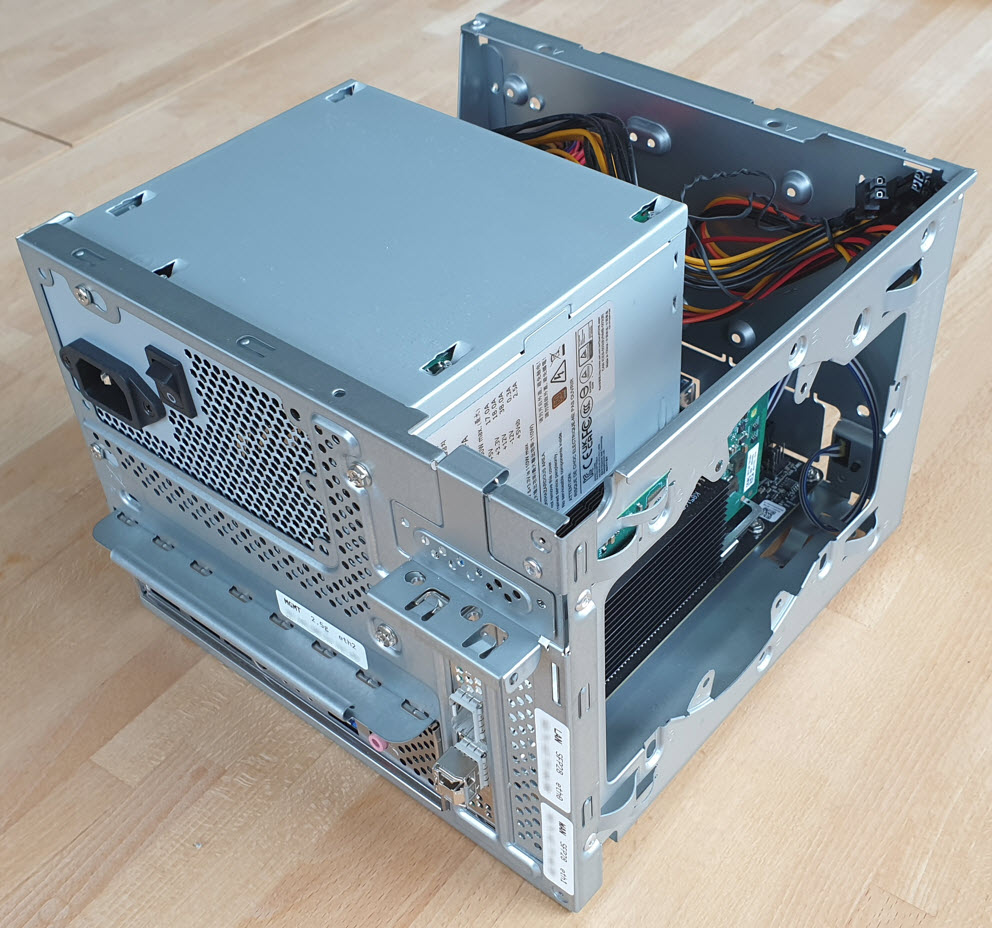
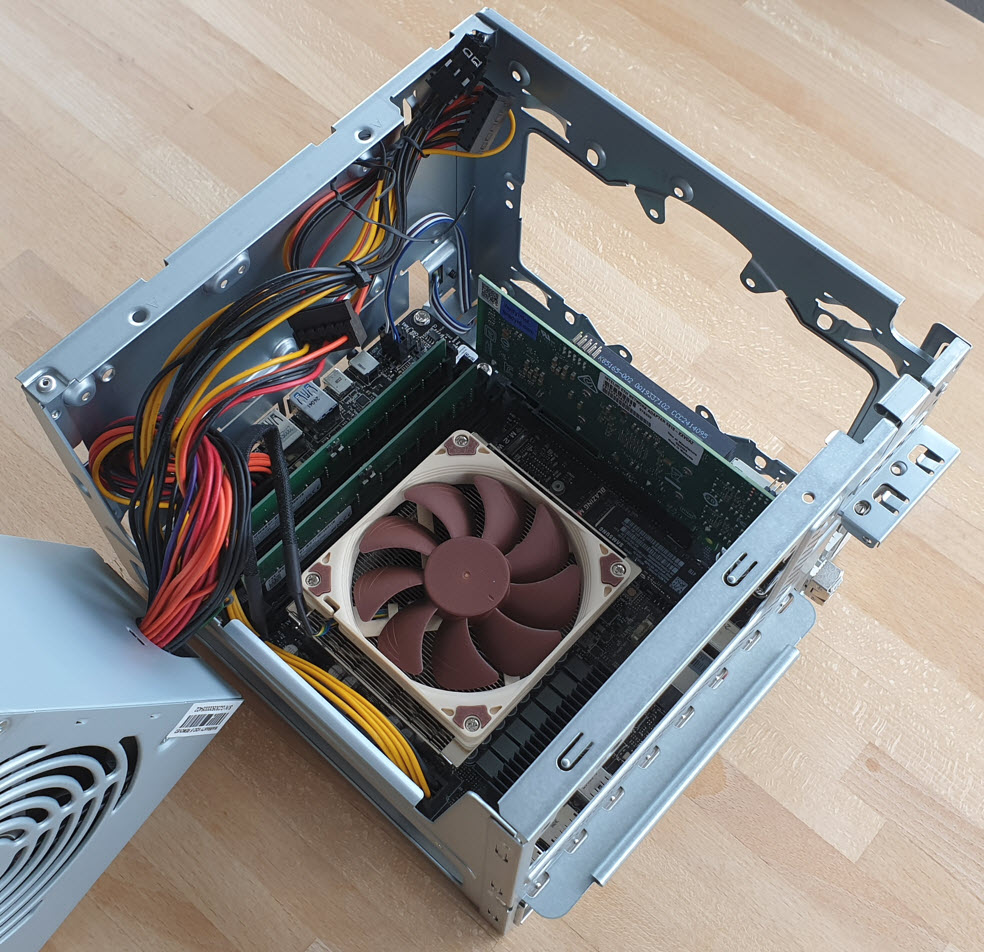
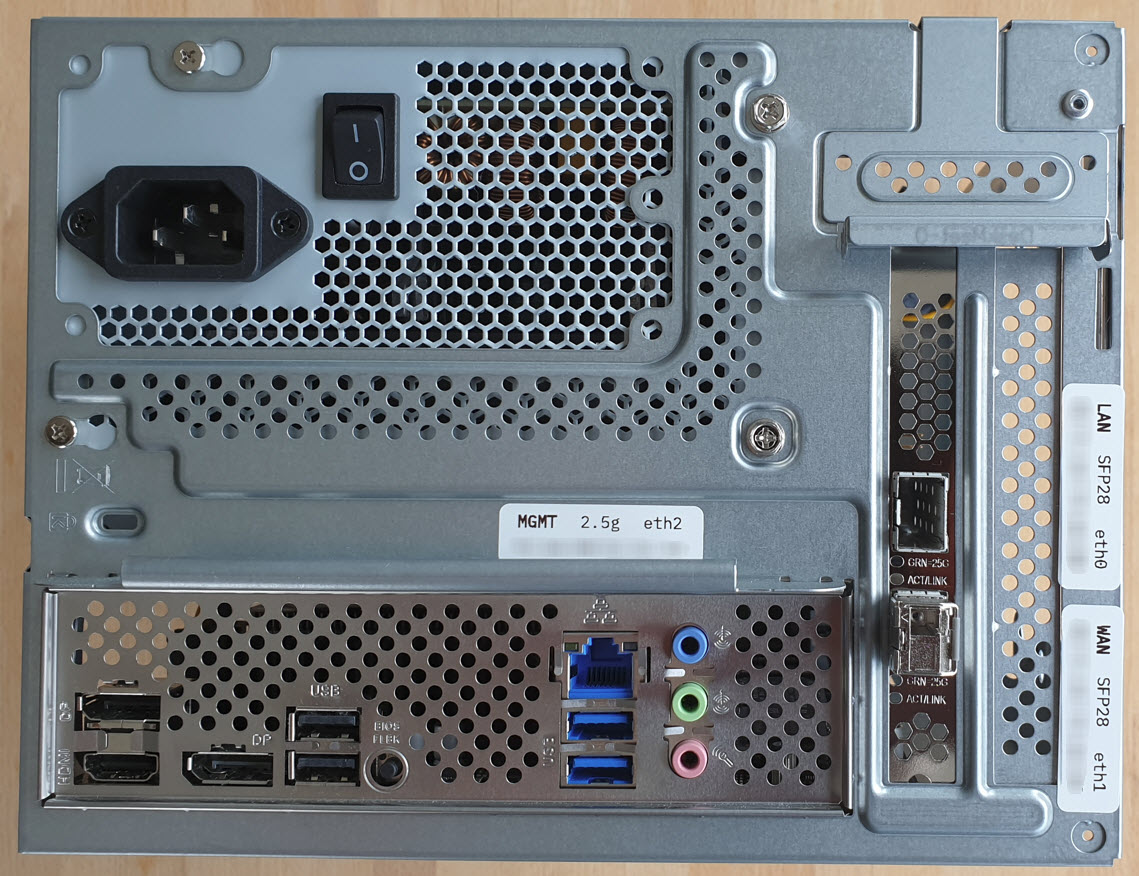
Future plans
As said before, I have decided against virtualization for now, as my
primary focus was on actually reaching 25gbit throughput. But seeing
that CPU load is very low, the platform could handle much more load
(for hosting some services), so perhaps I'll reconsider and run
Proxmox on the same setup in the future. But my first task will be upgrading my LAN infrastructure to >1 gbit. I'll start with some machines in close vicinity to the VyOS box, mainly my Synology boxes. My copper LAN wiring should also be good for 2.5/10 gbit, at least for short distances, so I will upgrade some PCs to at least 2.5 gbit. And my primary workstation (9 years old!) is overdue for replacement, so when that happens I'll go with 25 gbit right from the start and pull in a single mode fiber line to my home office.